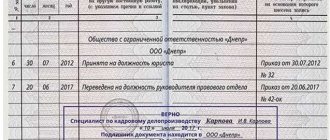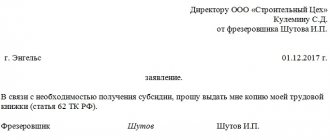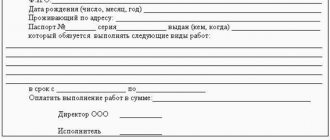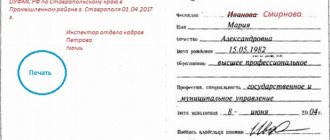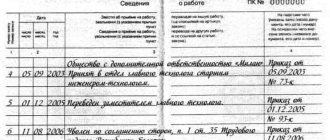Mirror of everyday life
A work book is an official document containing complete and reliable information about a person’s work activity. This information includes:
- about the employee;
- about the work he performs;
- about transfers to another permanent job;
- about dismissal;
- on the grounds for termination of the employment contract;
- about awards for success in work.
The work book contains the personal data of its owner and detailed information about his work activity at all places of work.
But records of penalties are not entered into the work book (unless the disciplinary sanction is dismissal). So, during my working life, the book turns out to be capacious, and for the most part it’s a pleasure to leaf through it. Although, of course, it was not intended for reading at all.
By the way, the work book was invented in monarchical France, back in the mid-eighteenth century. True, then her purpose was somewhat different from now: the requirement to present paper from the previous employer was due to the fight against vagrancy.
Why is all this needed?
In essence, a work book is a “working” biography of a person, written by impartial personnel officers. And as such, it performs several functions:
- the first and main function is that the work book confirms the employee’s length of service when assigning a pension;
- the second function is that it informs potential employers about the facts of a person’s work activity, his work skills, successes and reasons for dismissals;
- the third function is to assist the owner in the event of a labor dispute (for example, in case of disagreement with the reason for dismissal).
And although the Russian Pension Fund has been taking into account length of service according to the personalized accounting system for quite a long time, the legislator is in no hurry to abolish work records. This is due to periodic failures in the operation of this system, and to the insufficiency of the data available in it (in particular, those that are needed to confirm the presence of special experience that allows early retirement). In addition, the opportunity to study the “work background” of a person before hiring him is very useful for employers.
So, a work book today is an indispensable attribute of a representative of the working part of the country’s population. Where does it come from and what does it represent?
On what, by whom and for whom is the chronicle of everyday work written?
A work book is a strict reporting form that has several degrees of protection and is produced by the GOZNAK Association. It is a small book with the obligatory watermarks and serial number.
If desired, the work book can be further protected from counterfeiting using a special hologram - a three-dimensional image of the coat of arms of the Russian Federation, laser-applied onto a transparent adhesive film. Such a film cannot be peeled off without destroying it. Homemade production of a hologram is impossible, just as its separate purchase is impossible: a sheet with six holographic stickers is sold as an insert for a work book. As a rule, a hologram is pasted onto the title page of a book to protect one of its main elements (for example, the owner’s signature or the serial number of the form). This is usually done at the time of document creation, but the use of holographic stickers is not mandatory.
Although anyone can buy the required form at an office supply store, only the employer has the right to fill it out. More precisely, his responsible representative. Most often, this is done by HR employees. And if there is no such service at the enterprise, then any employee who has been granted the appropriate authority. So in order to get a work book, you will have to get a job, and officially.
The work book is a small, tightly bound book with the coat of arms of the Russian Federation on the cover.
The first entries in the work book are made at the time of the citizen’s first official employment. The Labor Code assigns to all employers (both legal entities and individual entrepreneurs) the obligation to maintain work records:
- for employees employed at their main place of work and who have worked for more than five days;
- for employees hired under a temporary employment contract;
- for seasonal workers;
- for freelancers who are subject to social insurance.
However, there is no rule without exceptions: if an employer uses hired labor, but is neither a legal entity nor an individual entrepreneur, the obligation to maintain work books does not apply to him. This is possible, for example, when an ordinary person hires a housekeeper. In this situation, the work book is not filled out.
In addition, a work book is not required when concluding a civil agreement with an employer.
What's hidden under the cover
The first meeting with your work book inevitably causes some trepidation, since it marks a new stage in life: transformation into a Working Person. And the strict cover of the document is quite appropriate for the moment. And under the cover, waiting in the wings, is a typographically printed blank, consisting of three sections:
- In the first section - directly on the title page - the basic personal data of the owner is entered (last name, first name, patronymic, date of birth, education received and specialty). After filling out, the page is certified by the signatures of the employee and the person filling out the book, as well as the seal of the enterprise.
- The second section contains detailed records of work activity: information about employers, hiring, transfers and dismissals. Each entry indicates the number of the corresponding order, and the last entry of each employer is certified by the seal of the enterprise. Ten spreads of the book are allocated for this section.
- The third section reflects information about the employee’s awards and incentives, indicating the dates, achievements and documents on the basis of which the corresponding entry was made. This section also has ten spreads.
The work book form is a blank page consisting of three sections; each section is intended for making entries of a certain nature
It happens that a person leads a rich and eventful work life, and the entries in the second or third section do not fit in the space allocated for them. Then an insert is issued for the work book - essentially the same book, but without a thick cover. Further entries are made in the appropriate sections of the insert, and the insert itself is sewn into the book and becomes an integral part of it.
Carry everything you have with you
When leaving the first official place of work for any reason, the employee takes his work book with him. Now, with each subsequent employment, the next employer will check it to ensure its authenticity and validity:
- will check the owner’s personal data with his passport and education documents;
- make sure that the last entry in the second section is a dismissal entry;
- will check the presence of the required signatures and seals.
If during such a check it turns out that the work book is filled out with violations, the employer will open a new one. But if the book does not contain a record of dismissal from a previous job, the applicant will not receive a new job: without such a record, he is considered working.
Sample application for issuing a copy of a work record book
When issuing a duplicate, the official who issued the document puts the inscription “Duplicate” on the title page and certifies it with his signature. An entry is made on the inside cover: “The duplicate was issued on the basis of ....”. The entry is dated, signed and sealed.
A unique opportunity to download any document in DOC and PDF absolutely free of charge. Only we have many documents in such formats.
In this case, the proposed sample will confirm that the plaintiff took the necessary measures to obtain evidence that did not bring any results.
You are writing a statement with a clear purpose, and you should convey here why you are contacting the addressee.
Subtle art of decoration
It would seem that what’s so difficult about filling out a blank space? A regular table with a header and a side panel. But in the case of a work book, filling out the form is regulated by three serious government documents, including one code, one government resolution and one resolution of the Ministry of Labor. And practice shows that, unfortunately, in most cases there are inevitable inconsistencies between different regulatory acts devoted to the same object of regulation.
Table: regulations of the Russian Federation regulating the filling out of work books
| Type of normative act | What approved the act? |
| Instructions for filling out work books | Approved by Resolution of the Ministry of Labor of Russia dated October 10, 2003 No. 69 |
| Regulations “On work books” (rules for filling out) | Approved by Decree of the Government of the Russian Federation dated April 16, 2003 N 225 |
| Labor Code of the Russian Federation | — |
If, when filling out a work book, a situation that is ambiguous from the point of view of legislation arises, it is necessary to be guided by the Labor Code as the document of the greatest legal force.
One-two-three
For work books, uniform general rules of registration have been established, according to which the entries made in them are mandatory:
- comply with the text of the relevant order;
- reflect all career events, including military service;
- in each section are numbered in order;
- do not contain any abbreviations;
- are made in Russian (for foreign enterprises operating on the territory of the Russian Federation, duplication of entries in another language is allowed; the same is possible for employers registered in the national republic of the Russian Federation, which has its own current language);
- contain only Arabic numerals;
- are carried out with black, blue or purple ink.
And of course, all entries must be made carefully and carefully so that errors or inaccuracies do not creep into the text, and subsequent corrections are not needed.
In general, filling out a work book occurs in three stages:
- Stage one is to check or fill out the title page (aka the first section of the book).
- Stage two is to make a record of admission, transfer or dismissal.
- Stage three - if necessary, enter information about the award or encouragement.
An appointment for an employee at his main place of work must be made within a week from the date of his return to work; The dismissal of an employee is formalized by a corresponding entry on the last day of his work.
Let's get acquainted, or show your passport
A new person who opens the door of an enterprise in search of work may already have work experience behind him or may not yet have it. When employing such an employee, the first step of the HR department employee depends on this: he either checks the information in the first section of the existing work book, or opens a book and fills out its first section. In both cases, to confirm personal data, the applicant is required to provide a passport and documents confirming receipt of education.
The first section of the work book is located on the title page and contains the personal data of the owner
Changes in personal data and their reflection in the work book
During the employee's work at the enterprise, events may well occur as a result of which his personal data will change. Since the work book at each current moment in time must reflect the real state of affairs, appropriate amendments will need to be made to its first section. Most often, such changes are associated with:
- with a change of surname after marriage or divorce;
- with a change in the employee’s qualifications;
- with changes in education level.
In such cases, the old data is crossed out and new information is entered. The entry containing it is made on the inside of the cover. This entry must indicate the document that serves as the basis for its registration (for example, a divorce certificate or a diploma of education received during work).
Photo gallery: examples of making changes to the data on the title page of the work book
Nuances of hiring, transferring and dismissing an employee
Records of an employee’s hiring, transfer to another position, or dismissal occupy the second section of the work book. Although making such entries is subject to general rules, there are still some differences in their design.
Table: hiring, transfer and dismissal of an employee: required elements of records
| Record type | Record element: serial number | Record element: date | Record element: business name | Record element: employee title | Record element: reason for hiring / transfer / dismissal (with reference to the Labor Code of the Russian Federation) | Record element: order number and date | Record element: signature of HR employee/company manager | Record element: employee signature | Record element: company seal |
| Employment Record | Required | Required | Required | Required | Not provided | Required | Not provided | Not provided | Not provided |
| Record of transfer to another position | Required | Required | Not required | Required | Not provided | Required | Not provided | Not provided | Not provided |
| Record of dismissal | Required | Required | Not required | Not required | Required | Required | Required | Required | Required |
If, before starting work, the employee completed compulsory military service, the first employer places a record of it before the employment record.
Photo gallery: samples of entries made in the second section of the work book
I'll write down how great you are
Perhaps the most pleasant part of the work book is the third, dedicated to awards and incentives. The assignment of new titles, the presentation of certificates, honorary diplomas and badges, the presentation of gratitude - in general, everything that is provided for in this regard by the legislation of the country and the collective agreement is reflected in the third section.
Records of awards and incentives are drawn up in the same order as the records of the second section of the work book, and at the same time they must contain a description of the employee’s achievements.
The award record is entered in the third section of the work book and contains a description of the employee’s achievements
An entry in the work book about rewarding or encouraging an employee is preceded by the name of the enterprise
How to be part-timers
It's no secret that living on one average salary can be somewhat difficult at times. Therefore (and also, probably, out of pure love for work), part of the working-age population finds part-time work. Or even several. Does this mean that in each such place a person will be issued a work book? Not at all.
No matter how many jobs a person has, he will have one work book, and it will be kept at his main place of work. But if the owner wishes, part-time work can be reflected in the work book using the appropriate entry.
To do this, the employee needs to take an official certificate from his non-main place of work, containing all the information necessary to fill out the book, and give it to the personnel service at the main place of work. Based on the information from such a certificate, a corresponding entry will be made in his work book.
A record of part-time employment is issued at the employee’s request by the personnel department at his main place of work.
The record of dismissal from a part-time job is not signed by an employee of the personnel service and is not certified by the seal of the enterprise: at the main place of work there is no reason for this (since the employee was fired from another enterprise), and at a non-main place there is no possibility (since the book is located at the place of the main job).
Video: how to make entries in a work book
Basic situations when it is required
Most often, a copy of the book is required in the following situations:
- When sending a request to a credit institution for a loan or loan. With the help of this document, bank employees make sure that a person has an official job in a certain position and has been working for a certain amount of time.
- When writing a resume and looking for a new job . It is not always easy to remember the names of all organizations where a person was previously employed. And it is even more difficult to decide on the dates of hiring and dismissal. In order to correctly compose a resume, as well as confirm to a potential manager your length of service and work experience, providing a copy of the book will be an excellent option during an interview. In most cases, the original book is required, but if you are not ready to quit and then just look for a job, this document can easily be replaced with a copy.
- To restore a duplicate book . If the book is lost or damaged, it must be restored. However, to make entries in a duplicate, confirmation of each entry will be required. In order not to request such information from each employer, you can confirm it with a copy of your book.
- For submission to the Pension Fund . When applying for various types of benefits and pensions, you will definitely be required to provide a copy of this document.
- For registration of various benefits and benefits in social security. In some cases, you will need to prove that you are employed and earning an income to receive certain benefits.
- During legal proceedings. For example, when a family union is dissolved, the spouse sometimes has to confirm that she is employed and will be able to provide a good life for the child. In the same way, the father must confirm his place of work and the income he receives in order for him to be assigned alimony payments in favor of the child.
- To obtain a visa to enter another country. The copy will indicate that you have a permanent income and are also tied to this country with work.
You can learn about some of these cases in more detail from the video presented.
Bank
Almost all credit institutions require their borrowers to provide proof of employment and income received. It is possible to obtain a loan without providing this information, but the conditions in this case will be extremely unfavorable for the borrower. Based on the information in the copy of the book, the bank receives the following information about the potential client:
- Main source of income . The company a person works for sometimes matters a lot. If he is a civil servant, an employee of a reliable bank or other large organization, this fact gives more confidence that the person will not be laid off without reason. And employment in small companies indicates a high chance of an employee being laid off.
- Amount of income . Depending on the specified position, bank employees can determine the potential amount of a person’s income, focusing on the average statistical data in this region. For example, bank employees will not believe that a cleaning lady will earn 50,000 rubles in a small town. And having seen a leadership position, they may assume that an income of 50,000 rubles is quite an objective amount for such a town.
- Employee length of service . Typically, many banks require that a person work in a new company for 3-6 months, and only after that they are ready to issue a loan. This is due to the fact that the first 3 months may be probationary. And in this case, termination of the employment agreement is carried out in a simplified manner. Also, not all employees can cope with the obligations assigned to them. And in this case, the person finds himself in a situation of risk of non-repayment of the loan. In another case, when a person has been working for a company for several years, the risks of his dismissal are much lower. Or at least, he will be able to find a job in advance before he leaves, which will provide him with a stable income.
- If payments are late, the bank knows the person’s place of work, so it will not be difficult for him to collect the due funds from his salary through writ proceedings .
Therefore, if you are planning to go to the bank to apply for a loan or credit, you will definitely need to order a copy of the book. Its production time should not exceed 3 days, so take care of it in advance.
For Pension Fund
Currently, a person’s entire length of service is reflected in the Pension Fund’s electronic database. Every employed employee has a SNILS. This is a number that allows him to be identified in the general database of the working population. This database now stores all information about employers, terms of work, length of service and payments made. In the future, based on this information, pension payments are calculated.
However, not all information is entered into the database, but only for the last 15-16 years. Therefore, in most cases, to confirm the length of service, those who are now retiring are required to provide a book. But not all retirees quit their jobs right away. By law, they have the right to work as long as they can cope with their responsibilities. In this regard, in order to receive their first pension payments, they are required to present a copy of the book.
Obtaining a visa
Russian citizens cannot enter all countries of the world without restrictions. And the conditions for obtaining a visa in each country may be different. For example, to apply for Schengen it is mandatory to present documents confirming your employment. If a person does not work anywhere and does not have his own business, which he can document, it is almost impossible to obtain a visa to the EU countries.
The host country must ensure that you are kept under obligations in their home country and that you are not detained illegally abroad.
Previously, a copy of the book was required when obtaining a foreign passport. But now there is no need for it. If, when registering for a foreigner, you are required to present a copy, know that this is illegal.
Work record and human factor
It may very well be that a person who, as part of his job, is involved in the preparation of work books, is no less interested in the correctness of their execution than the owners. And because the retirement future of people partly depends on his work (and this, you see, is a huge responsibility), and because he will have to correct mistakes if something happens. But we are all human, and people tend to make mistakes, even if they really don’t want to.
Fortunately, it is impossible to make irreparable mistakes when filling out a work book. True, crossing out for the purpose of correction in the second and third sections is not allowed. An incorrect entry is simply invalidated and the correct one is made.
Erroneous entries in the second and third sections of the work book are not crossed out; to correct an error, make an entry about their invalidity, and then make a correct entry
Yes, it's that simple. But it’s still better not to make mistakes.
Basic Rules
The basis for issuing a copy is the application submitted by the employee. But this rule applies more to large and medium-sized enterprises with a large number of employees. In small businesses and entrepreneurs, a copy may be issued upon the oral request of the applicant. But so that you are not delayed in issuing such a document, I recommend that you always draw up an application for its issuance.
It is necessary to copy all pages on which entries were made. Copies must be made from the very first sheet, which contains information about the owner of the book. And the last copy will be a sheet with a mark from the last place of work.
Copies can be certified in 2 ways:
- Certify each sheet separately . Then you need to confirm “Correct” on each of them or write “Copy is correct.” The applicant is also required to write his position, last name, sign and affix the organization’s seal. In addition, it is necessary to date the certification of photocopies.
- Fasten all the sheets together with firmware and attach additional paper on which the number of sheets will be indicated . There is also an inscription on it stating that “Copy is correct” or “Correct.” It is necessary to indicate the position of the person filling out, his full name and put a stamp. Don’t forget to also put the date on which the copies were made.
After the main certification, a phrase must be written on the copy stating that the person continues to work. Be sure to indicate that it is currently working.
The following have the right to sign:
- HR department employees;
- accountant;
- director;
- entrepreneur.
If the organization has a seal, it must be affixed. If it is absent, you must make the entry “ Believe without a seal .”
A copy must be issued no later than three days after receiving a request from an employee.
Spitting copy
There are situations in life in which an employee may need a copy of his work record. This is normal practice, and, in accordance with Article 62 of the Labor Code, the employer must provide the requested document within three days.
When do you need a copy of your work record?
There are actually quite a lot of cases when a person may need a copy of his work record:
- when applying for a loan of any type in a banking institution;
- to restore a lost work book (if you have a certified copy, this is much easier to do);
- for writing a resume;
- for presentation to the pension fund;
- to obtain a passport;
- to obtain a business or work visa.
Or, for example, when a person is looking for a new job without quitting his old one, and wants to confirm his work experience to a potential employer. In general, there are a lot of options.
Copy of copy of discord
In order for an official institution to accept a copy of a work book for consideration, this copy must meet the requirements for the preparation of such documents. And in order for a copy of the work book to be regarded as a correctly executed document, it is not enough to simply make copies of its completed pages. These copies need to be properly certified.
There are two possible procedures for certifying a copy, and the choice of the appropriate one depends on the current location of the work book:
- at the employer at the place of main work;
- in the hands of a temporarily unemployed owner.
If the book is located at the enterprise, copies of its facing pages will be taken by a personnel service employee. He will fasten them and put the company’s seal on each one in such a way as not to cover the text. Next to the seal will be placed:
- the inscription “Copy is correct”;
- the job title of the employee who filled out the copy;
- signature of this employee;
- date of completion of the copy.
At his request, a copy of the employee’s work book is prepared by the inspector of the HR department, certifying it with the seal of the enterprise and his signature
If the owner of the book is temporarily unemployed and the book is in his hands, he will have to contact a notary office to certify its copy.
When to apply for a work book
The validity period of a copy of a work book issued as a duplicate is unlimited. This document is subsequently used by the employee until the end of his work experience. However, as a general rule, the relevance of a certified copy, especially if it is provided to a financial institution, is one month.
The document can be written on a standard blank A4 sheet, either by hand or on a computer. The main condition: the presence of the applicant’s original signature.
If the latter needs to provide information from it to any authority, the personnel officer must make a copy or extract from the work book. But the trigger for starting this process is a written statement from the employee.
In the upper right corner it is reflected to whom this statement is intended and, accordingly, from whom it is made. The official document is submitted to the official representative of the company, therefore, you need to indicate:
- the addressee's position;
- name of the enterprise;
- Full name of the head.
Hard-won duplicate
Suppose that when changing jobs, a person lost his work book: he took it from one enterprise, but did not bring it to another. What should he do in this situation? Forget about honestly earned work experience and hopes for a decent pension? After all, by definition, the new employer in this case will simply create a new record book for him, and the counting of the employee’s length of service will again start from scratch.
Fortunately, there are duplicate work books for just such a case. This one and a few more:
- in case the work record is lost by the employer;
- in case the work book becomes unusable (stained, torn, burnt, etc.);
- in case the entries made in the work book about dismissal or transfer to another job are declared invalid by a court of law;
- in case due to force majeure circumstances (catastrophes, natural disasters, etc.) there is a massive loss of work records by the employer.
A duplicate work book has the same legal force as the original. Under one condition: it must contain absolutely the same information.
Where to go for a duplicate
Technically, the task of issuing a duplicate of the employee’s lost work record book lies with his last employer. It is to him that you should contact him with a corresponding statement.
To obtain a duplicate of a lost work book, an employee must apply to his last former employer
But in order to issue a duplicate work book, the employer must have information about all previous places of work of his former employee. And the task of such an employee is to transfer all the necessary information to the personnel department. This can be done by providing:
- copies of employment contracts;
- certificates from previous places of work;
- extracts from orders for employment and dismissal (copies thereof);
- certificates from state or municipal archives.
How to fill out a duplicate
A duplicate of the work book is issued on a new form. Wherein:
- “Duplicate” is indicated on the title page in the upper left corner; all basic information about the employee is filled out in accordance with the general procedure;
- on the first spread of the book in the section “Information about work”, the employee’s total length of service earned before employment at his last former place of work (that is, with the employer who draws up the duplicate) is first indicated;
- further, the duplicate indicates periods of work with specific employers based on copies of documents and certificates from previous places of work provided by the employee; these records are not numbered;
- the numbering appears in the duplicate, starting with the line with the record of the employment of this employee at the enterprise whose personnel department issues the duplicate.
Filling out a duplicate work book has a number of features; in particular, the first entry contains information about the total work experience of the owner of such a duplicate
Does the employer have the right to refuse to issue a copy?
The original work book must be permanently kept by the HR department of the enterprise. It is not issued to an employee for submission to a bank or other institution.
My employer doesn't want to pay me my salary. They gave an advance in the amount of 3 thousand rubles. and that's it! And the employment contract states 12,000. The rest of the money is 9 tr. do not give. They say there is no money. They've been harassing me for 2 weeks now. Although the employment contract clearly states the timely payment of wages. I want to sue my employer, I was advised to contact the prosecutor's office. What should I do, where should I go?
The only limitation is that the documents must relate to this employee personally and must contain his last name.
Typically, a copy is required by various government agencies or large financial organizations. Moreover, it may be in demand for a second job, for example, for part-time work. How to get a duplicate? Obtaining the required number of copies of a work record book is quite simple.
The same applies to writing the word “statement” - with a capital letter or a lowercase letter; you can compose a statement in different ways.
The reasons why a borrower cannot repay loans can be very different. What are the consequences of not repaying a loan or how to behave correctly if you find yourself in such a difficult situation.
There is no legally approved sample application for a copy of a work record. As a rule, such statements are drawn up in a relatively arbitrary form, but a number of organizations and institutions also have internal rules that strictly regulate both the form and procedure for submitting this document.
The reasons why a borrower cannot repay loans can be very different. What are the consequences of not repaying a loan or how to behave correctly if you find yourself in such a difficult situation.
An important circumstance is the fact that the effect of the copy (except for the requesting party's rules regarding deadlines) also depends on the original document.
The work record book is transferred to the employee only at the time of dismissal from the organization, and upon subsequent employment it is again transferred to the personnel service.
We don’t need someone else’s, we would like to take our own
It just so happens that in modern times, rarely anyone manages to work their entire life in one place. People change jobs for various reasons: some are looking for career growth, some are looking for decent pay, while others simply can’t sit still.
Upon resigning, on the last day of work the employee must receive the salary due to him and pick up his work book. Moreover, the book must be issued even if this employee:
- did not hand over material assets or special clothing;
- did not submit the bypass sheet;
- is a financially responsible person, and through his fault, damage was caused to the employer.
But this is in theory. In practice, there are often cases when an employer tries in every possible way to delay the issuance of a work book to an employee, pursuing some of his own goals. In such a situation, how can you explain to your former boss that he is very wrong?
It is worth reminding him that when dismissing an employee, the legislator allows not to issue a work book only in two cases:
- if the employee does not show up for work;
- if the employee refuses to collect the documents.
In the first case, the book is sent to the owner by mail. In the second, the employee is sent a special notification about the need to pick up the document. From the moment such notification is sent, officials of the enterprise are not responsible for violating the deadlines for issuing the book.
An employer who unreasonably refuses to issue a work book in a timely manner deprives the employee of the opportunity to get another job and, thus, violates his right to work. And responsibility for such a violation lies not only with management, but with the entire enterprise as a whole.
Violation of labor legislation and other regulatory legal acts containing labor law norms, unless otherwise provided by parts 3, 4 and 6 of this article and article 5.27.1 of this Code, entails a warning or the imposition of an administrative fine on officials in the amount of one thousand to five thousand rubles;
for persons carrying out entrepreneurial activities without forming a legal entity - from one thousand to five thousand rubles; for legal entities - from thirty thousand to fifty thousand rubles. Art.
5.27 Code of Administrative Offenses of the Russian Federation (as amended by Federal Law dated July 3, 2016 N 272-FZ) https://www.consultant.ru/document/cons_doc_LAW_34661/7ff50b874c8cbce814266fd45eb5fff8b30449b6/
In addition, if a person was unable to work for some time due to the lack of a work book due to the fault of a former employer, such a person is entitled to compensation for the entire period of forced downtime at the expense of this employer. This is what the Labor Code says.
If a simple reminder of the rules of the law and responsibility for violating them does not seem convincing enough to the former employer, the work book will have to be retrieved with the involvement of a third party: the labor inspectorate or the court.
If an employer does not hand over a work book when dismissing an employee, you can go to court to protect your interests.
Moreover, contacting Rostrud is even preferable, since the labor inspectorate in this case can conduct a full inspection of the enterprise. And few people dream about this, in fact.
In any case - by persuasion, with the help of the labor inspectorate or through the court - the employee has every opportunity to defend his rights and take back his work book. Yes, and receive the required financial compensation.
Copy requirements
Remember that you cannot make a copy of your book yourself, as it must be properly certified. The registration procedure will be as follows:
- Copies of all completed pages must be made.
- It is necessary to have a stamp or signature that the copy is correct, indicating the date of the position and the signature of the certifier.
- It is important to have a signature stating that the employee is still working.
- Since July of this year, it is mandatory to have a signature stating where the original book is kept.
There must also be a seal of the company whose employee certified this document. If the organization does not have a seal, the signature “Believe without a seal” must be written.
Every employer is required to know these filling rules. However, in practice, errors and inaccuracies are often made. To avoid them, each employee must also know the procedure for certifying a copy.
Keepers of labor chronicles
A work book is an important official document, so its storage and recording is a responsible and serious matter. So responsible that two structural divisions of enterprises are involved in it: human resources and accounting.
Since work books and their forms are strictly accountable documents, they are required to be stored in a safe or a separate room to ensure safety. Such documents are issued only upon application.
Accounting for work book forms, the books themselves and inserts is carried out using two documents:
- receipt and expenditure book for accounting of work book forms and inserts in it;
- books for recording the movement of work books and inserts in them.
Moreover, the first book is kept in the accounting department of the enterprise, and the second in its personnel department.
In the income and expenditure book, the accountant takes into account the receipt of the relevant forms at the enterprise and their transfer to the personnel service at its request. In the accounting book, the HR specialist records the work books of hired employees and work books that were first opened at the enterprise (their receipt, establishment and delivery).
Both books must be:
- numbered;
- laced;
- sealed;
- certified by the signature of the head.
Photo gallery: storage and accounting of work books, their forms and inserts
And although in 2021 it is planned to transfer work books of Russian citizens into electronic form, for some time, along with them, paper documents familiar to everyone will be used. And, accordingly, the order of their recording and storage will continue.
Drawing up an application
There is no unified, uniform sample application for issuing a copy of the work book, so the employee can write it in free form or in a form developed at the enterprise. Applications must include a number of required information:
- information about the company where the person works,
- position and full name of the employee in whose name it is written,
- request for a copy,
- date,
- compiler's signature.
If desired, you can indicate the reason why a copy was required, as well as the authority to which the document is required to be presented, but if there is no such desire, then, by law, the employee is not obliged to write this.
